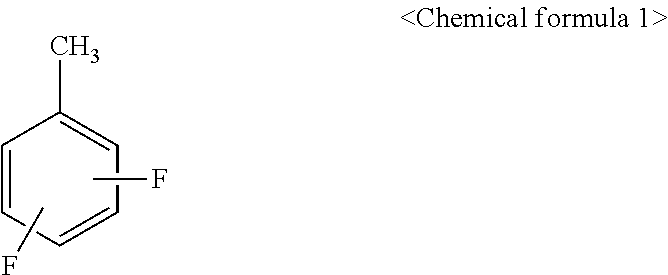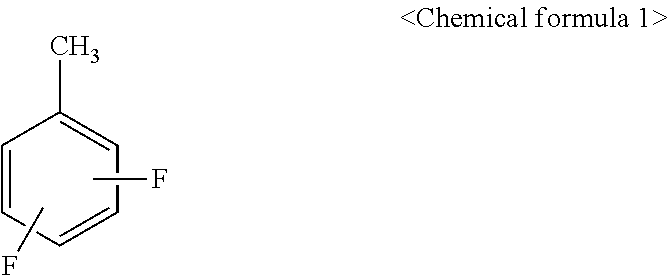[0019]When a battery is exposed to
high voltage conditions such as
overcharge due to malfunction of a charger or
carelessness of a user, difluorotoluene in contained in the non-aqueous electrolyte solution according to the present invention is oxidized earlier than an
organic solvent to form a thin film on an
anode, whereby gas generation resulted from
decomposition of the organic
solvent is remarkably reduced. Accordingly, problems that may occur during setup of mobile phones or notebook computers due to
increased thickness of a battery, or likelihood of explosion or firing caused by inner
pressure increase and
thermal runaway of a battery may be prevented.
[0020]Also, a lithium secondary battery comprising the non-aqueous electrolyte solution for a lithium secondary battery according to the present invention may enhance basic performance of a battery including
high rate charge /
discharge characteristics, cycle life characteristics, and the like.BEST MODE
[0021]Hereinafter, the present invention will be described in detail. Prior to the description, it should be understood that the terms used in the specification and the appended claims should not be construed as limited to general and dictionary meanings, but interpreted based on the meanings and concepts corresponding to technical aspects of the present invention on the basis of the principle that the inventor is allowed to define terms appropriately for the best explanation.
[0022]A non-aqueous electrolyte solution for a lithium secondary battery according to the present invention includes a lithium salt and an organic
solvent, and further includes difluorotoluene, represented by the following
chemical formula 1, having a lowest oxidation potential of difluorotoluene among components of the non-aqueous electrolyte solution.
[0023]where the position of
fluorine is at least one selected from the group consisting of 2,3-, 2,4-, 2,5-, 2,6-, 3,4-, and 3,5-. That is, difluorotoluene represented by the
chemical formula 1 may use 2,3-difluorotoluene, 2,4-difluorotoluene, 2,5-difluorotoluene, 2,6-difluorotoluene, 3,4-difluorotoluene, or 3,5-difluorotoluene, singularly or in combination. In particular, it is found that when the position of
fluorine is any one of 2,5-, 3,4-, and 3,5-, swelling of a battery under high
voltage conditions such as overcharge is remarkably reduced.
[0024]As described above, the conventional arts disclose non-aqueous electrolyte solutions including a variety of
halogen-containing aromatic compounds to suppress gas generation caused by decomposition of an electrolyte solution. However, the conventional arts merely mentioned difluorotoluene as one of a variety of
halogen-containing aromatic compounds, and they did not actually use difluorotoluene as a
halogen-containing aromatic compound. Also, the conventional arts did not suggest or specify the remarkable effects of difluorotoluene for inhibition of decomposition of a non-aqueous solvent. According to the conventional arts, it was found that the used
fluorine-substituted aromatic compounds did not reduce gas generation to a desired level when overcharged. That is, it was found that when overcharge continues, an amount of gas generated in the presence of these compounds reached a level sufficient to open a vent intended for safety of a battery. This is a fatal drawback under the existing circumstances in which safety of a battery is raised as a great issue.
 Login to View More
Login to View More  Login to View More
Login to View More 


